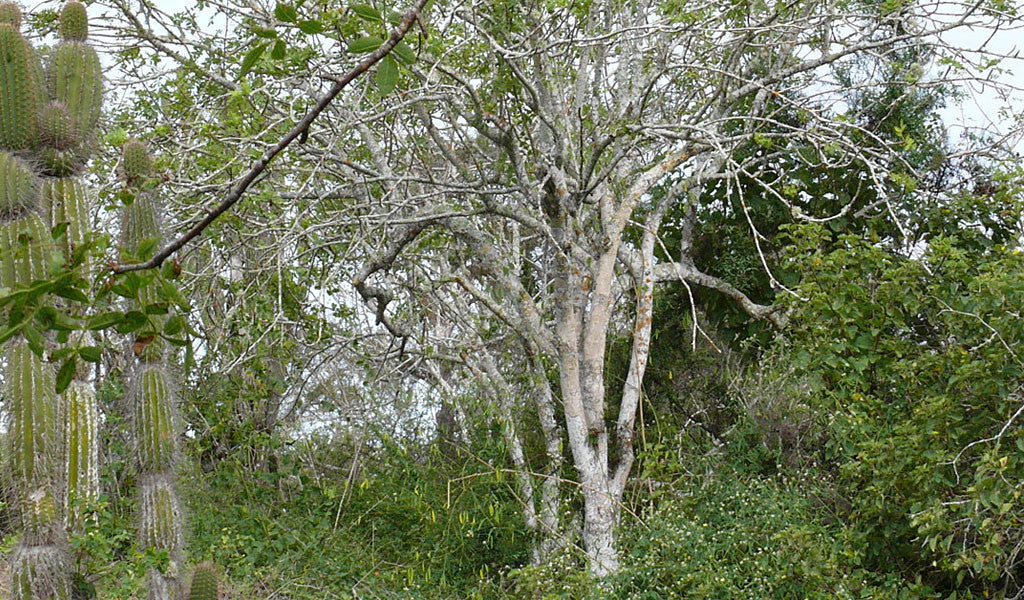 Palo santo (bursera graveolens) is an aromatic and sacred tree that grows naturally in the South American forest, and is admired by shamans and scientists alike. The properties that shamans use it for are truly amazing and its uses are numerous, including spiritual purification, fighting diseases, and simply enjoying its woody and peculiarly pleasant aroma, to name just a few. For centuries, palo santo remained a hidden treasure known only to the people of South America. Thanks to globalization, however, it has recently been discovered by the rest of the world and is rapidly gaining
Palo santo (bursera graveolens) is an aromatic and sacred tree that grows naturally in the South American forest, and is admired by shamans and scientists alike. The properties that shamans use it for are truly amazing and its uses are numerous, including spiritual purification, fighting diseases, and simply enjoying its woody and peculiarly pleasant aroma, to name just a few. For centuries, palo santo remained a hidden treasure known only to the people of South America. Thanks to globalization, however, it has recently been discovered by the rest of the world and is rapidly gaining  popularity. Palo Santo products include sticks to be burned or boiled for tea, cone incense, and essential oil, as well as secondary products such as massage oils, topical creams, and aromatic boxes. Unfortunately, fame has its drawbacks. As palo santo products become popular, more trees are required to satisfy the growing demand, and the once copious population of palo santo is rapidly diminishing. South American shamans teach that palo santo trees should be treated with reverence and must not be cut down. One may only harvest the wood of those trees that died of their own accord and stayed on the forest floor for several years. This teaching also has a practical side to it, as palo santo’s aromatic and therapeutic qualities can only develop fully in the aged heartwood harvested from naturally fallen trees. However, not all woodsmen are environmentally conscious enough to follow this ancient wisdom. Some think only of the immediate gain and indiscriminately harvest from dead and living trees alike, contributing to the severe deforestation of palo santo. This creates the real threat that, at some point, there will be no palo santo trees left for our children and grandchildren to admire and benefit from. That is why organizations concerned for the fate of palo santo have taken steps to preserve this mystical and mysterious tree for future generations.
popularity. Palo Santo products include sticks to be burned or boiled for tea, cone incense, and essential oil, as well as secondary products such as massage oils, topical creams, and aromatic boxes. Unfortunately, fame has its drawbacks. As palo santo products become popular, more trees are required to satisfy the growing demand, and the once copious population of palo santo is rapidly diminishing. South American shamans teach that palo santo trees should be treated with reverence and must not be cut down. One may only harvest the wood of those trees that died of their own accord and stayed on the forest floor for several years. This teaching also has a practical side to it, as palo santo’s aromatic and therapeutic qualities can only develop fully in the aged heartwood harvested from naturally fallen trees. However, not all woodsmen are environmentally conscious enough to follow this ancient wisdom. Some think only of the immediate gain and indiscriminately harvest from dead and living trees alike, contributing to the severe deforestation of palo santo. This creates the real threat that, at some point, there will be no palo santo trees left for our children and grandchildren to admire and benefit from. That is why organizations concerned for the fate of palo santo have taken steps to preserve this mystical and mysterious tree for future generations.
Ensuring future generations of palo santo in Ecuador’s rainforest
 In Ecuador, one of palo santo’s principal habitats, this wonderful tree is being taken care of by CORFAM (Corporacion Forestal y Ambiental de Manabi/Forestry and Environmental Corporation of Manabi). CORFAM is a not-for-profit organization attached to the prefecture of the Ecuadorian province of Manabi, where the rainforest thrives. CORFAM is dedicated to the reforestation of those areas that have been affected due to deforestation and poor farming practices. As a part of the Reforestation National Program, it seeks to protect and preserve native species, and achieve sustainable and harmonious environmental development. For this purpose, CORFAM uses various endemic plants, including palo santo, to establish forest plantations and thus provide local woodsmen with a source of income. Besides supplying the farmers with saplings and seeds for their work, CORFAM also offers them training, support, and technical assistance. The advantages of this organizational policy are threefold: the trees are protected from extinction, the harvesters benefit from an improved economic and environmental situation, and the poverty levels in the country go down. Thus, in the short time between 2007 and 2009, the CORFAM reforestation project benefited about 12,000 farming families of the Manabi province.
In Ecuador, one of palo santo’s principal habitats, this wonderful tree is being taken care of by CORFAM (Corporacion Forestal y Ambiental de Manabi/Forestry and Environmental Corporation of Manabi). CORFAM is a not-for-profit organization attached to the prefecture of the Ecuadorian province of Manabi, where the rainforest thrives. CORFAM is dedicated to the reforestation of those areas that have been affected due to deforestation and poor farming practices. As a part of the Reforestation National Program, it seeks to protect and preserve native species, and achieve sustainable and harmonious environmental development. For this purpose, CORFAM uses various endemic plants, including palo santo, to establish forest plantations and thus provide local woodsmen with a source of income. Besides supplying the farmers with saplings and seeds for their work, CORFAM also offers them training, support, and technical assistance. The advantages of this organizational policy are threefold: the trees are protected from extinction, the harvesters benefit from an improved economic and environmental situation, and the poverty levels in the country go down. Thus, in the short time between 2007 and 2009, the CORFAM reforestation project benefited about 12,000 farming families of the Manabi province.Palo Santo Reforestation Project
Palo santo reforestation is a very meticulous process that requires a lot of labor and time. Firstly, those who want to plant it have to find abandoned land for the future plantation. Luckily, the land does not need to be particularly fertile as palo santo normally grows in nutrient poor areas, including such dry places as rocky slopes and abandoned quarries. Next, they have to harvest palo santo’s tiny, half-inch fruit. Each piece of fruit contains a single black seed surrounded by red pulp and protected by a green outer capsule. When the fruit ripens it drops to the ground one-by-one or in pairs, so over the course of a month, the harvesters need to return to the forest every few days to gather them. At the next stage, the tree planters mix nutrient rich soil with natural fertilizers, such as palo santo sawdust and palo santo aromatic water. This mixture is burned to produce black soil that is then put into plastic bags, and in each bag are three palo
Next, they have to harvest palo santo’s tiny, half-inch fruit. Each piece of fruit contains a single black seed surrounded by red pulp and protected by a green outer capsule. When the fruit ripens it drops to the ground one-by-one or in pairs, so over the course of a month, the harvesters need to return to the forest every few days to gather them. At the next stage, the tree planters mix nutrient rich soil with natural fertilizers, such as palo santo sawdust and palo santo aromatic water. This mixture is burned to produce black soil that is then put into plastic bags, and in each bag are three palo  santo seeds. When the seeds germinate, they are placed into another bag, where they grow short and abundant roots. At this point, the seedlings are already stable enough and can be planted to become a part of the new Palo Santo forest. Unfortunately, the germination rate of the palo santo seeds is rather low (only about 3-16%), and it is not easy to grow a seedling, increasing the delicate nature of palo santo reproduction. roots.
santo seeds. When the seeds germinate, they are placed into another bag, where they grow short and abundant roots. At this point, the seedlings are already stable enough and can be planted to become a part of the new Palo Santo forest. Unfortunately, the germination rate of the palo santo seeds is rather low (only about 3-16%), and it is not easy to grow a seedling, increasing the delicate nature of palo santo reproduction. roots.
The UN and Palo Santo Reforestation Projects
 The CORFAM reforestation project is fully acknowledged and supported by the Food and Agriculture Organization of the United Nations (FAO). FAO is a United Nations agency that seeks to eliminate hunger, reduce poverty, and promote the sustainable management of natural resources. Among its other endeavors, it facilitates the establishment of forest plantations, which play an increasingly significant role as the size of the natural forest is constantly dwindling. In South America, Palo Santo is one of the most suitable species for such reforestation programs, as it grows relatively fast and does not require fertile soil. Besides producing oxygen and providing both food and habitat for many kinds of birds, it also creates favorable conditions for other species of trees that flourish under its green canopy.
The CORFAM reforestation project is fully acknowledged and supported by the Food and Agriculture Organization of the United Nations (FAO). FAO is a United Nations agency that seeks to eliminate hunger, reduce poverty, and promote the sustainable management of natural resources. Among its other endeavors, it facilitates the establishment of forest plantations, which play an increasingly significant role as the size of the natural forest is constantly dwindling. In South America, Palo Santo is one of the most suitable species for such reforestation programs, as it grows relatively fast and does not require fertile soil. Besides producing oxygen and providing both food and habitat for many kinds of birds, it also creates favorable conditions for other species of trees that flourish under its green canopy.
Prabhuji’s Gifts contributes to the Reforestation Project organized by the Forestry and Environmental Corporation of Manabi, Ecuador (CORFAM), an entity acknowledged by the Food and Agriculture Organization (FAO) of the United Nations.
Translated from FAO website: http://www.fao.org/forestry/18484-08ca617eae41f2f48d8652b75460a7f8f.pdf http://www.fao.org/countryprofiles/index/en/?iso3=ECU&subject=5 The (CORFAM) (Forestry and Environmental Corporation of Manabi, Ecuador) facilitated the establishment of approximately 50,000 hectares offorest plantations of the commercial, protective and agroforestry type between 2007 and 2009, benefiting about 12,000 farming families in the Manabi province of Ecuador, a province affected by a severe process of degradation and desertification of its coastal mountain area due to excessive deforestation and poor farming practices. CORFAM is an operating unit for promoting reforestation, appointed to the prefecture of the Manabi province. It has been very effective in achieving its goals due to the implementation of the following institutional policy: "Economic profits and environmental benefits of the plantations and organizational development promoted by CORFAM belong to their owners, the benefit for the State being poverty reduction among its people." With the purpose of providing support and training for the farmers, CORFAM contracts with NGOs and / or companies expert in participatory rural development. These entities employ experienced local farmers (both men and women) that assist farming families in developing a forestry plan. This plan reflects the property’s forestry potential in relation to market conditions or farmers’ needs. Through continuous evaluation, valuable lessons are constantly being made: • Technical assistance and continuous support are more important than economic incentives. • The principal incentive for planting trees is good markets. • The more the farmer is involved, the better the result. • In case of adverse weather conditions, it is essential to follow a strict forestry calendar. • Geo-referencing each plantation is an excellent way to prove the facts to the doubters. • There are few private entities capable of working with farmers, hence the need for training. • The information on forestry technology is controlled by the private sector, hence the need for cooperation agreements. Finally, it was established that farmers require much more than trees for the reforestation of their farms. Therefore, CORFAM will shortly launch a program of integral watershed management supported by FAO (Food and Agriculture Organization of the United Nations http://www.fao.org/).
Conclusion
 By buying Palo Santo products from Prabhuji’s Gifts, you also help to preserve this precious tree, as part of the profits go toward financing the Palo Santo Reforestation Project organized by Forestry and Environmental Corporation of Manabi (CORFAM) and fully acknowledged and supported by the Food and Agriculture Organization of the United Nations (FAO). Our palo santo wood comes from the Machalilla National Park, Ecuador, which has the largest palo santo population in South America and is protected by local law. Our woodsman has vast experience in the sustainable management of palo santo and harvests only naturally fallen branches and trunks, without cutting down any living trees, damaging the surrounding area or making new paths. For every old tree that dies, a young one is planted to make sure that the number of palo santo trees is steady and growing.
By buying Palo Santo products from Prabhuji’s Gifts, you also help to preserve this precious tree, as part of the profits go toward financing the Palo Santo Reforestation Project organized by Forestry and Environmental Corporation of Manabi (CORFAM) and fully acknowledged and supported by the Food and Agriculture Organization of the United Nations (FAO). Our palo santo wood comes from the Machalilla National Park, Ecuador, which has the largest palo santo population in South America and is protected by local law. Our woodsman has vast experience in the sustainable management of palo santo and harvests only naturally fallen branches and trunks, without cutting down any living trees, damaging the surrounding area or making new paths. For every old tree that dies, a young one is planted to make sure that the number of palo santo trees is steady and growing.








0 comments